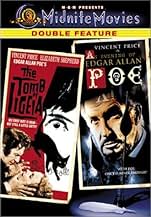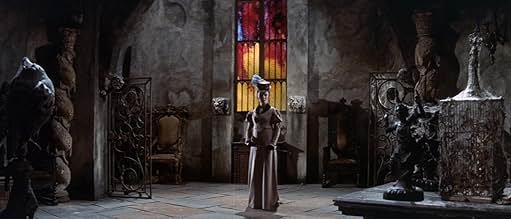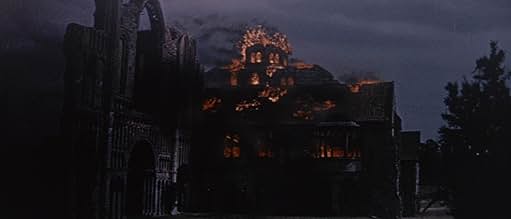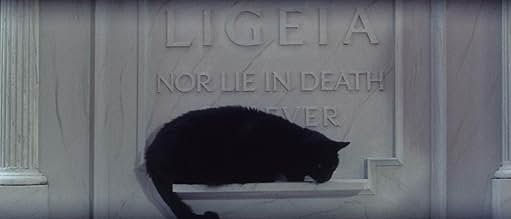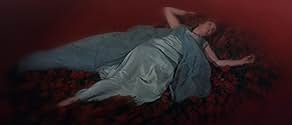IMDb RATING
6.4/10
7.3K
YOUR RATING
A man's obsession with his dead wife drives a wedge between him and his new bride.A man's obsession with his dead wife drives a wedge between him and his new bride.A man's obsession with his dead wife drives a wedge between him and his new bride.
- Director
- Writers
- Stars
Maxwell Craig
- Wedding Guest
- (uncredited)
Anthony Lang
- Wedding Guest
- (uncredited)
Del Watson
- Footman
- (uncredited)
Fred Wood
- Wedding Guest
- (uncredited)
- Director
- Writers
- All cast & crew
- Production, box office & more at IMDbPro
Featured reviews
"The Tomb of Ligeia" was one of a cycle of films made by Roger Corman in the sixties based on the works of Edgar Allen Poe. Verden Fell, an English country gentleman of the 1820s has become obsessed with his dead wife Ligeia. Indeed, although she has been buried in a tomb he built for her, he believes that she is not dead but has, as she promised she would, survived death in some form and will return to him. This obsession survives Fell's remarriage to Rowena, the daughter of a neighbouring landowner. Indeed, his obsession worsens, as he comes to believe that Rowena is possessed by Ligeia's spirit.
This is an unusual horror film in that much of it takes place not only outdoors but also in daylight. The sort of images of ruin and decay traditional in horror films- Fell lives in a gloomy, crumbling, cobwebbed manor house close to the ruins of a mediaeval abbey- are contrasted with sunlit scenes of the beautiful, verdant English countryside. The difference between life and death is the central idea of the film- which ends with a quote from Poe himself: "The boundaries which divide life from death are at best shadowy and vague. Who shall say where the one ends and where the other begins"- so this contrast is possibly symbolic, with the outdoor scenes symbolising life and the indoor ones death. The two main female characters (both played by the same actress, Elizabeth Shepherd) are differentiated in a similar manner. Rowena is a healthy-looking, "English Rose" type blonde with a love of outdoor pursuits, especially hunting. Ligeia is dark haired and gaunt with an unhealthy pallor.
Like many films of this period, and unlike later films such as "The Exorcist", this is an example of an understated horror film, with the horror mostly being implied rather than shown directly. Ligeia makes an appearance in the film, but we are never sure whether this is really her ghost returning from the grave or a hallucination conjured up by Fell's distraught mind. Although it is understated, however, it is genuinely frightening, not because of Exorcist-style special effects, but because of the eerie mood that Corman is able to create. Apart from the atmospheric setting, various objects take on a sinister significance- a bunch of flowers, a dead fox and, most of all, a mysterious, malevolent black cat which may be the reincarnation of Ligeia's soul, or may be just a cat.
The acting is also very good, especially from Shepherd in the dual role of Rowena/Ligeia and from Vincent Price as Fell. In a way this is also a dual role, as there are two separate aspects to Fell's character. On the one hand he is sinister and frightening, the man who threatens Rowena's happiness, her sanity and even her life. (The adjective "fell" significantly means cruel or fierce). On the other hand he is a pitiable character, a victim of his own obsessions and (possibly) also of his late wife's ghost. This duality is very much in keeping with the mood of the film, which is one of ambiguity and doubt. As befits one based upon the work of Poe, it is a tale of mystery and imagination. 7/10
This is an unusual horror film in that much of it takes place not only outdoors but also in daylight. The sort of images of ruin and decay traditional in horror films- Fell lives in a gloomy, crumbling, cobwebbed manor house close to the ruins of a mediaeval abbey- are contrasted with sunlit scenes of the beautiful, verdant English countryside. The difference between life and death is the central idea of the film- which ends with a quote from Poe himself: "The boundaries which divide life from death are at best shadowy and vague. Who shall say where the one ends and where the other begins"- so this contrast is possibly symbolic, with the outdoor scenes symbolising life and the indoor ones death. The two main female characters (both played by the same actress, Elizabeth Shepherd) are differentiated in a similar manner. Rowena is a healthy-looking, "English Rose" type blonde with a love of outdoor pursuits, especially hunting. Ligeia is dark haired and gaunt with an unhealthy pallor.
Like many films of this period, and unlike later films such as "The Exorcist", this is an example of an understated horror film, with the horror mostly being implied rather than shown directly. Ligeia makes an appearance in the film, but we are never sure whether this is really her ghost returning from the grave or a hallucination conjured up by Fell's distraught mind. Although it is understated, however, it is genuinely frightening, not because of Exorcist-style special effects, but because of the eerie mood that Corman is able to create. Apart from the atmospheric setting, various objects take on a sinister significance- a bunch of flowers, a dead fox and, most of all, a mysterious, malevolent black cat which may be the reincarnation of Ligeia's soul, or may be just a cat.
The acting is also very good, especially from Shepherd in the dual role of Rowena/Ligeia and from Vincent Price as Fell. In a way this is also a dual role, as there are two separate aspects to Fell's character. On the one hand he is sinister and frightening, the man who threatens Rowena's happiness, her sanity and even her life. (The adjective "fell" significantly means cruel or fierce). On the other hand he is a pitiable character, a victim of his own obsessions and (possibly) also of his late wife's ghost. This duality is very much in keeping with the mood of the film, which is one of ambiguity and doubt. As befits one based upon the work of Poe, it is a tale of mystery and imagination. 7/10
Of all the collaborations between director Roger Corman and sensuous, creepy actor Vincent Price, this is probably their best. There's the small cast of characters, mainly Ligeia, buried in a marble tomb in the grounds of a sinister old abbey, Rowena, a lady horserider looking for someone she can be 'drawn' to who is more interesting than her beau Christopher, and Verdon, Ligeia's bereaved husband, with his black shades and mood swings. There's also a cat. And this cat is really the true star of the film, watching, attacking, influencing.
The film benefits from its heavy use of locations, and makes it stand apart from the studio interiors of other adaptations. This is a decadent, decaying England with strange happenings and curses. It is a superb film, and lifts the Shepperton Poe adaptations to a new level.
The film benefits from its heavy use of locations, and makes it stand apart from the studio interiors of other adaptations. This is a decadent, decaying England with strange happenings and curses. It is a superb film, and lifts the Shepperton Poe adaptations to a new level.
There is an assumption among movie fans that the longer a movie series exists, the worse the later films will be. Although the films Roger Corman made of some of the stories of Edgar Allan Poe began well and continued with no obvious sense of decline, it is my opinion that the best was kept for last. The most overtly spectacular film in the series was 'The Masque of the Red Death' with its fine sense of colour and effective sense of homage to Ingmar Bergman's 'The Seventh Seal'. I have always enjoyed this film and in terms of a deliberate departure from the series norm, it is exceptional. However one enjoys any series for the familiar as well as the unusual, and in this respect 'The Tomb of Ligeia' is the most memorable for me in the way it builds upon and enhances what has gone on in previous films. The logical departure from the previous films which had been (very happily and effectively) studio-bound, was to move to location. Corman's choice of Castle Acre Priory in Norfolk, was an inspired one. An large amount of location filming was done there and this grounded the film in a realistic (yet unusual)setting. Gone were the fog machines and 'blasted heath' effects of 'House of Usher' and 'The Premature Burial'. Many critics have mentioned their disquiet at the absence of Barbara Steele, at that time undoubtedly the actress most associated with this type of picture. Wonderful though Miss Steele was in, say, the last thirty minutes of 'The Pit and the Pendulum', I feel that the presence of the English actress, Elizabeth Sheppard, adds to the sense of realisim, while taking little away from the shock effect of one actress playing both a good and an evil role. Roger Corman is on record as saying that he had to keep a written record as to when Rowena was herself and when she was Ligeia. All I can say that it is happily obvious on the screen when each side of the romantic coin is in evidence. I think that Elizabeth Sheppard's performance, grounded in reason, and when added to the inevitable polish that was being obtained by this stage in the series, showed a welcome extra sense of belief, to point out the advances and progression that had been made by this, the last film, in the series. Two scenes stand out : the entrapment of Rowena in the bell tower by the black cat (representing Ligeia.) I am also very impressed by Rowena's hynotism ; first to her own childhood and then to the persona of Ligeia. This film has not been available for viewing in the UK for many years. It is to be hoped that this situation will be reversed before long. I remember with affection the moment when great talents (from both sides of the 'pond') collaborated with great effcetiveness to come up with the ultimate 'Corman Classic'.
I was asked recently if I could name any genuinely scary films made before The Exorcist in 1973. The only titles I could come up with were Rosemary's Baby and Night of the Living Dead from the late '60s. I could suggest many horror titles made before 1970, but none were genuinely flesh-crawling enough to make the list. At the time, I had not seen The Tomb of Ligeia. Now I have seen it and, wow! This is one seriously under-rated gem.
It is one of the many Roger Corman films from this era based on an Edgar Allan Poe story. Intelligently scripted by Robert Towne, and acted to perfection by Vincent Price and Elisabeth Shepherd, this film is a treat from start to finish. Shepherd plays a well-to-do lady in Victorian England who falls in love with a mysterious loner (Price) who resides in a crumbling abbey and seems haunted by memories of his previous (now-dead) wife Ligeia. She marries Price, but her chances of love are blighted by spooky happenings which may be the work of the ghost of his jealous ex-bride.
The dream sequence, featuring a dead fox hidden in a bouquet of flowers and a terrifying metamorphosis midway through a passionate kiss, is a marvellous and memorable scene. All scenes featuring the weird black cat are eerily effective. There's also a wonderfully creepy hypnotism episode. The photography is lovely, with colourful outdoor lensing of a real English abbey and superb blending of light and shadows during the ghostly indoor sequences.
So, if you're after a truly spine-tingling film from before 1970 - here you go!
It is one of the many Roger Corman films from this era based on an Edgar Allan Poe story. Intelligently scripted by Robert Towne, and acted to perfection by Vincent Price and Elisabeth Shepherd, this film is a treat from start to finish. Shepherd plays a well-to-do lady in Victorian England who falls in love with a mysterious loner (Price) who resides in a crumbling abbey and seems haunted by memories of his previous (now-dead) wife Ligeia. She marries Price, but her chances of love are blighted by spooky happenings which may be the work of the ghost of his jealous ex-bride.
The dream sequence, featuring a dead fox hidden in a bouquet of flowers and a terrifying metamorphosis midway through a passionate kiss, is a marvellous and memorable scene. All scenes featuring the weird black cat are eerily effective. There's also a wonderfully creepy hypnotism episode. The photography is lovely, with colourful outdoor lensing of a real English abbey and superb blending of light and shadows during the ghostly indoor sequences.
So, if you're after a truly spine-tingling film from before 1970 - here you go!
At one point in this film Vincent Price says 'Christopher, not ten minutes ago I tried to kill a stray cat with a cabbage'. Now, I think that is a pretty good reason alone to watch this movie but if that's not enough for you well, its another Roger Corman gothic horror starring Vincent the magnificent, based loosely on an Edgar Allen Poe story. There's nice sets and locations, lush cinematography, an above average script and Price doing what he does best, as well as vegetable-based violence directed at felines.
Did you know
- TriviaShot on a 25 day schedule in the UK, a big difference to the 15 day schedule used in the US for the previous Roger Corman "Poe" movies. The director attributed the extra time to the British crew's obsession with taking "tea breaks."
- GoofsPosition of Ligeia's arms when lying in bed. When Rowena fall on her her arms are in a position like holding something. Few minutes later, when Verden take a look on the bed hidden by the black curtains, their arms are in other position.
- Quotes
Verden Fell: Christopher, not ten minutes ago I... I tried to kill a stray cat with a cabbage, and all but made love to the Lady Rowena. I succeeded is squashing the cabbage and badly frightening the lady. If only I could lay open my own brain as easily as I did that vegetable, what rot would be freed from its grey leaves?
- ConnectionsFeatured in Nightwatch Presents Edgar Allan Poe: The Tomb of Ligeia (1973)
Details
- Runtime
- 1h 22m(82 min)
- Color
- Aspect ratio
- 2.35 : 1
Contribute to this page
Suggest an edit or add missing content



